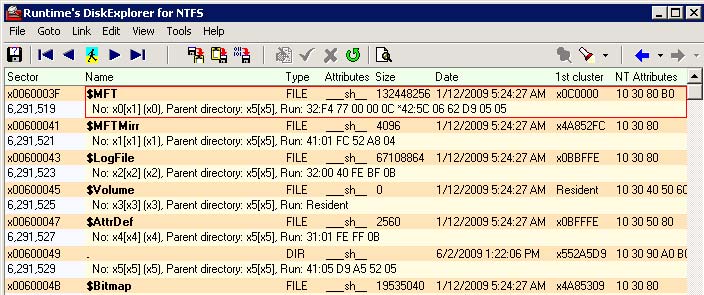DiskExplorer for FAT
Windows based Disk Editor for Windows and Linux File Systems

Product Highlights
- Navigate and inspect your hard drive
- Robust search feature
- Create virtual volumes
|
|
Runtime's DiskExplorer for NTFS
Windows based Disk Editor for NTFS file systems
This sophisticated disk editor enables you to investigate your NTFS drive and conduct your own data recovery, using the following features:
- Navigate your NTFS drive by jumping to the partition table, boot record, Master file table or the root directory
- Choose between views such as hex, text, index allocation, MFT, boot record, partition table
- Inspect the file entry details, NT attributes etc.
- Search your drive for text, partition tables, boot records, MFT entries, index buffers
- View files
- Save files or whole directories from anywhere on the drive
- Identify the file a certain cluster belongs to
- Create a virtual volume when the boot record is lost or corrupt
- Edit your drive by using the direct read/write mode (not recommended) or the virtual write mode
- Conduct your own data recovery by taking advantage of all these features
Runtime's DiskExplorer for FAT
Windows based Disk Editor for FAT file systems
This powerful disk editor enables you to:
- Navigate your drive going directly to the partition table, boot record, FAT, root directory, to a certain sector etc.
- Switch between several views, such as hex, text, directory, FAT, partition table and boot record view
- Search your drive for text, boot records, partition tables and sub directories
- Investigate the volume' s boot record by looking at the volume information
- Edit your drive by using the direct read/write mode (not recommended) or the virtual write mode
- View and recover even deleted files
- Create a virtual volume when your boot record is lost or corrupted
- Conduct your own data recovery by taking advantage of all these features.
Runtime's DiskExplorer for Linux
Windows based Disk Editor for EXTFS2 & EXTFS3
This is the newest addition to our successful line of disk editors. Have an fresh new look at your Linux EXTFS2 or EXTFS3 file system:
- Navigate your drive by going directly to the partition table, superblock, inodes, groups etc.
- Switch between several views, such as hex, text, directory, partition table, superblock, inode and group description
- Search your drive for text, superblocks and partition tables
- Edit your drive by using the direct read/write mode (not recommended) or the virtual write mode
- View and recover files
- Create a virtual volume when your superblock is lost or corrupted
- Conduct your own data recovery by taking advantage of all these features.

